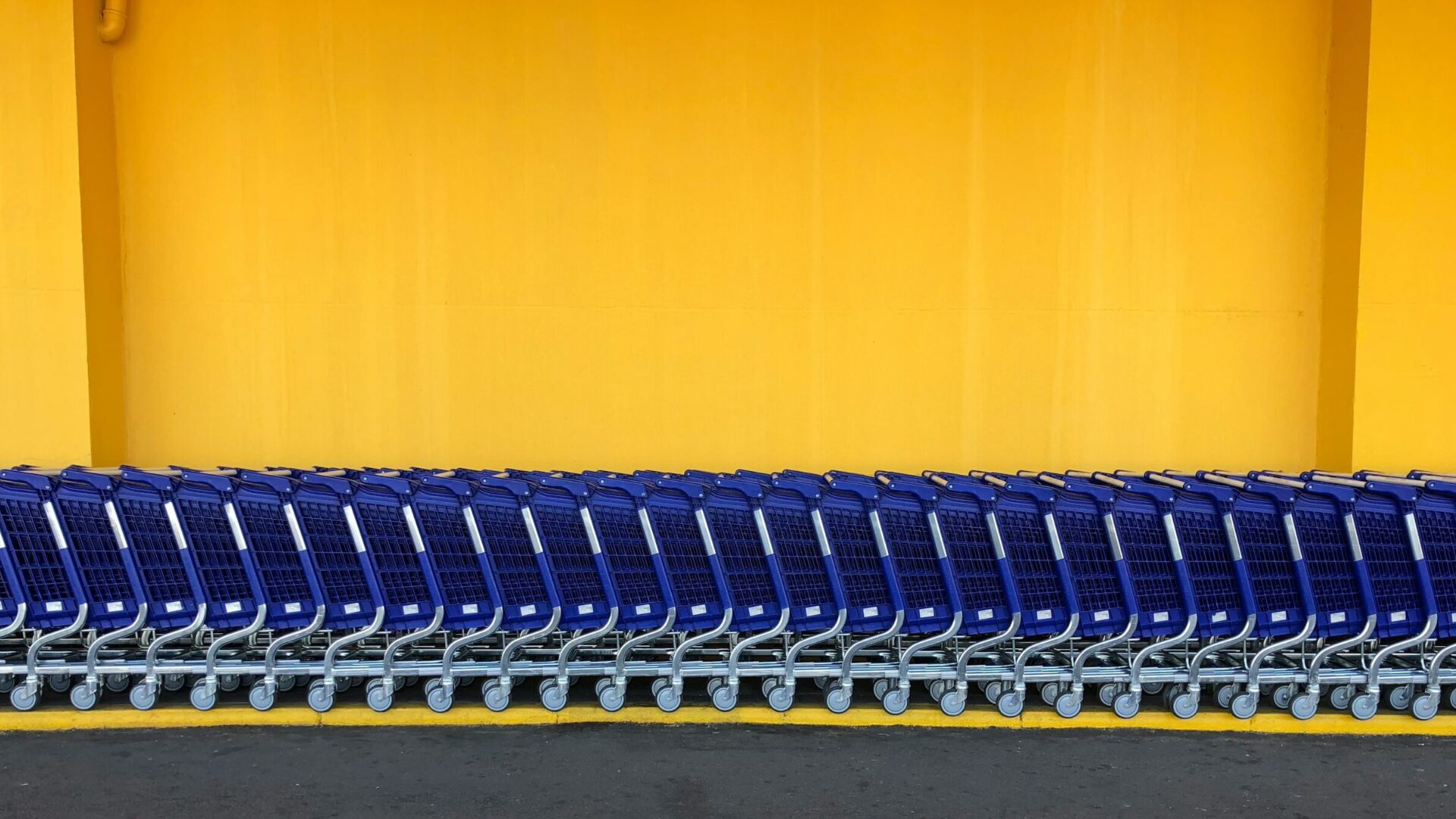Can Amazon figure out IRL – that’s millennial speak for “In Real Life” – grocery?
The long-term struggle of Amazon Fresh stores has long been documented. And in early April, The Information reported that Amazon announced it would remove its Just Walk Out (JWO) technology at Amazon Fresh stores across the U.S., including in its stadiums and arenas.
Instead, Amazon will debut Dash Carts, which will allow customers to scan their items using cart technology while shopping. The carts do not require any interaction with a cashier, which was the original goal of JWO technology in the first place. As grocers and retailers continue to find the best combination of cashier and self-checkout technology, has Amazon found the solution to consumer convenience, technological prowess, and swift retail hacks for the stream-happy Gen Z generation and beyond?
Why JWO Didn’t Work
There are 44 Amazon Fresh stores in the country and 27 use the JWO technology. Per The Information, the tech will still be used at the 20+ C-store-style Amazon Go locations, and smaller Amazon Fresh stores in the UK, and within some third-party retailers.
People love convenience. People love technology. For the most part, people tolerate grocery shopping. So why didn’t JWO technology work out?
“We have been predicting Amazon would discontinue JWO in grocery for some time,” said Will Glaser, CEO of Grabango, to TFI.
“[Amazon] did a great job of eliminating the line, the conveyor belt, and all the barcode scanning. This remains the way consumers will soon demand that all retail operate,” Glaser noted, adding that JWO technology was prohibitively expensive to install and that it drove up operating costs because store teams had to constantly monitor that each item for sale was exactly in the right place all the time for the system to work. According to Glaser, the additional labor hours needed to support JWO far outweighed its potential cost savings.
“The [JWO] system relied on shelf sensors and isn’t suitable for regular grocery stores at any scale,” he added. “The shelving must be completely replaced or materially modified. And even in small stores, those shelf sensors create thousands of single points of failure and must be brought down weekly for maintenance. This is all very expensive.”
Most importantly, however, Glaser added that JWO requires significant compromises on the part of those it was intended to help – the common consumer – rendering the in-store shopping experience notably less convenient than more.
“Because of the shelf sensors, JWO stores can’t easily rotate end caps or reconfigure shelf space without engineering involvement, severely limiting the ability to run co-op promotions to drive sales. For the same reasons, JWO also doesn’t support secondary displays, special deal aisles, seasonal items, or other high-margin merchandising programs.”
Take a dart and throw it at a calendar, and you could name several federal, celebrated, or adopted holidays that most grocers rely upon to drive sales. If JWO technology killed those promotions – and the limited-time offers and foodstuffs that came with them – consumers are left with basic staples such as bread, water, soft drinks, and snacks. And those can be found anywhere.
Will Smart Carts Roll to Success?
Most people have stronger opinions about how and why they shop the way they do than they’re willing to admit (or even know about). Budget, proximity, convenience, ambiance, selection…these all play into every consumer’s mindset when considering the next move when the pantry begins to run dry or the refrigerator is running low.
And like the grocery store itself, opinions run the gamut from widespread adoption to gradual acceptance to “it’s too early to tell.”
“I expect widespread adoption, and I think consumers will respond very positively,” said Andy Keenan, executive vice president and general manager at Advantage Solutions, to TFI.
“Placing an item in a cart is something that consumers are accustomed to, rather than simply walking out of a store. It almost feels more transactional. Placing an item in a cart is a physical activity, and many shoppers keep sort of a running tally in their head about how much they’re spending when they place an item in a cart.”
Keenan adds that Dash Carts are a much simpler concept for consumers to wrap their heads around than explaining how Just Walk Out technology works. In fact, Keenan believes JWO technology may have in fact been more ahead of its time than the general public is really prepared for, much like the Google Glass phase of almost 10 years ago (!) and the more recent foray by Meta and other companies into the virtual and digital spaces.
“Dash Carts could very well be a bridge to a path that leads back to JWO,” Keenan said. “Dash Carts are a correction, and as more of them become available in more stores, and as more consumers get accustomed to using them — and not having to wait in check-out lines or take time to use self-checkout lanes — JWO may come full circle.”
Others aren’t so sure.
“Grocery retailers and shoppers are looking for better checkout solutions,” Glaser continued.
“We don’t believe smart carts are an answer for retailers. Grocery retailers have been experimenting with smart carts for more than 20 years without much success.”
Glaser noted that the Dash Cart requires shoppers to scan the barcode for each product they want to buy before putting it into their carts, begging the questions, “how much time does this possibly save?”, and “What operator errors can be introduced into the POS transaction aisle to aisle, department to department?”
He also added that increased shrink is possible due to multiple legacy POS levels and that adoption of smart carts remains stuck in the low single-digit percentages.
Instead, Glaser points to checkout-free technology as a viable solution for future grocery and retail.
“Retailers are poised to rapidly adopt checkout-free technology because it delivers a better experience to shoppers and higher margins to retailers. In addition, checkout-free enables enhanced analytics on things like shrink, out-of-stock levels, and retail media performance that helps retailers make dramatic improvements to store operations.”
Consumers Will Decide the Future of Smart Cart Technology
The future of checkout technology, consumer perception and adoption, and operator success is a tricky set of balls to keep in the air all at once.
“Since we haven’t seen much use of Dash Carts in the U.S. to this point, it will take some time before this technology is widely implemented and adopted,” said Len Covello, CTO of global loyalty technology provider Engage People, to TFI.
“Consumers will need to be educated and get experience using these smart carts before they buy in. Once the early adopters get comfortable, they will become advocates, particularly those who understand the benefits.”
Amazon believes this may be the case for its technology, hoping that a successful rollout of Dash Cart technology in its branded stores (including Whole Foods) may lead to more widespread adoption of its technology to other grocers and retailers.
“According to Amazon, this includes faster, more convenient shopping that is tailored to the individual consumer. Adoption will also increase if Amazon applies learnings from other markets and implements changes based on customer input and concerns.”
Most importantly, Covello stressed that any adoption of new technology requires buy-in from all parties, and that as stores continually stress the overall experience of in-store shopping to attract tomorrow’s consumers, there are plenty of ways for consumers to get what they’re looking for.
“Operators looking to prepare for the implementation of new checkout technology need to remember that technology does not benefit the customer if it does not deliver a positive experience,” Covello said. “It should help to maximize product selection and decrease complexity to make the shopping and checkout process as frictionless as possible.”
“All of the trends we see in consumer behavior exist, in part, because we’ve trained consumers to behave the way they’re behaving,” Keenan added, zooming out a bit to consider the overall grocery/retail experience (and how rapidly it’s changing).
“Over time, with technologies like these, consumers will learn new shopping behaviors, which will bleed into several years of gradual changes. There’s a long runway here for operators to adjust and get it right.”
The Food Institute Podcast
From lattes to chicken sandwiches to desserts, it seems every restaurant is hopping on the limited-time offer (LTO) craze to drive traffic and check growth. But is this really having the desired effect? Datassential vice president of sales Megan Lynberg discusses the historical data on LTOs, popular LTO items, and other strategies companies are using to inspire growth.











